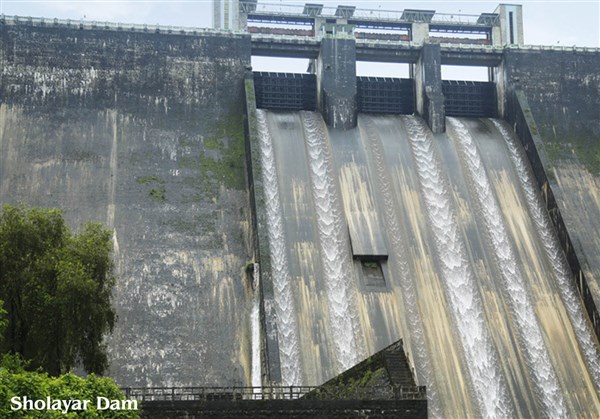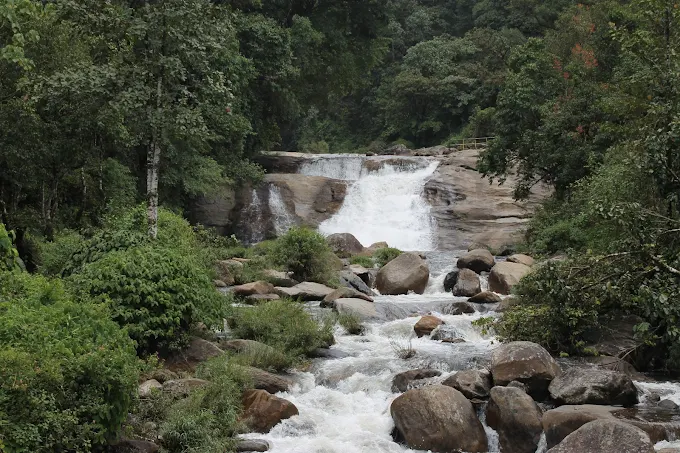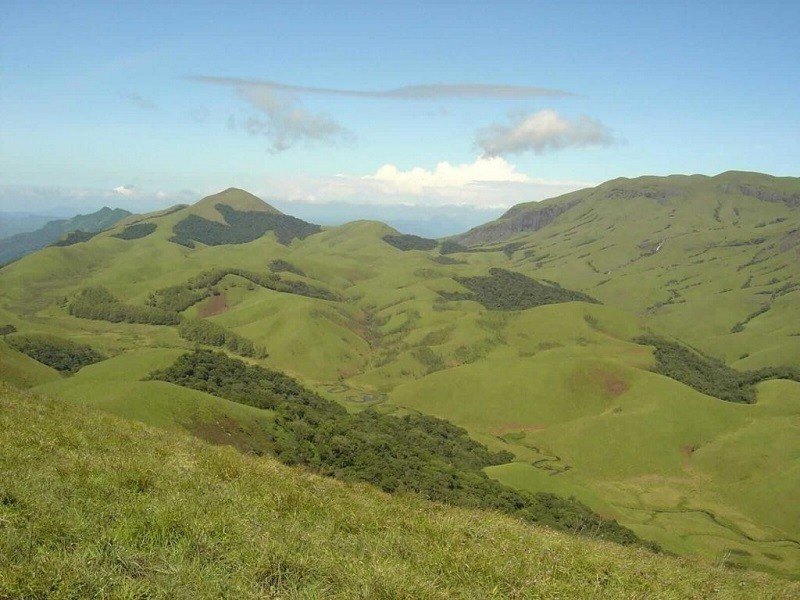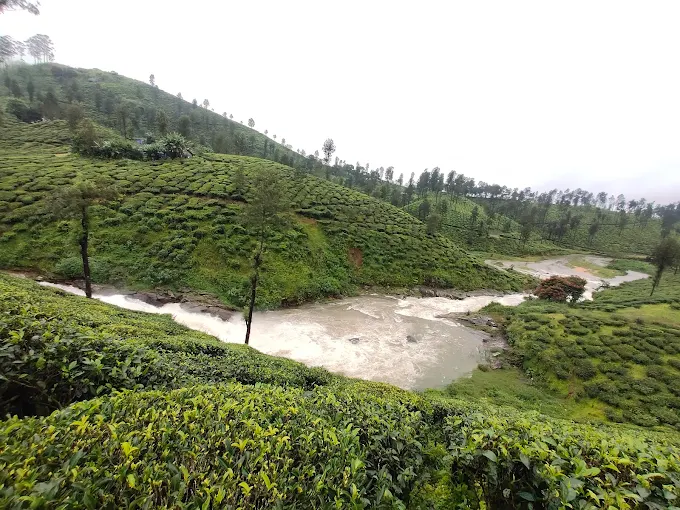Location & Infrastructure
Sholayar Dam, also known as the Upper Sholayar Dam, sits about 20 km from Valparai, perched at around 3,500 ft elevation in the Anaimalai Hills of Tamil Nadu. The dam is part of the Solaiyar Hydroelectric Project, comprising the main dam, a flanking dam, and a saddle dam, commissioned in 1964–65.
Its structural dimensions include a height of 66 m, length of 430.6 m, and reservoir covering approximately 8.7 km², with storage capacity of ~5.42 TMC ft (≈ 153.6 million m³) and active capacity 5.31 TMC ft.
Sholayar feeds into the larger Parambikulam Aliyar Project (PAP)—an integrated water‑power irrigation network using waters from eight rivers, including Sholayar and Aliyar, serving irrigation needs in both Tamil Nadu and Kerala across over 97,000 ha land and generating over 600 MW power.
Seasonal Significance & Water Releases
During the southwest monsoon (June–September), heavy inflows often lift the reservoir to Full Reservoir Level (FRL) of 160 ft (~49 m). When FRL is reached, sluice gates open, releasing water—sometimes ~4,000 cusecs—downstream into Kerala’s Parambikulam reservoir, via PAP canals as per inter‑state agreements.
Tourists on the Rise
Since mid‑July this year, repeated gate openings and full reservoir visuals have dramatically increased visitor numbers at Sholayar Dam. Even before official tourist amenities, people from Tamil Nadu, Kerala, and Karnataka began reaching Valparai overnight to witness the early-morning spectacle. Social media platforms are now flooded with selfies and reels capturing the gushing waters during gate openings. Recent reports cite weekend visitor numbers exceeding 2,000 per day in peak monsoon periods.
DATA SNAPSHOT
| Metric | Value / Detail |
|---|---|
| FRL (Full Reservoir Level) | ~160 ft (~49 m) |
| Reservoir Area | ~8.7 km² |
| Live (Usable) Capacity | ~153.6 million m³ (~5.42 TMC ft) |
| Official Opening Year | 1965 |
| Distance from Valparai | ~20 km |
| Tourists per Peak Day | ~2,000+ |
| States of Visitor Origin | Tamil Nadu, Kerala, Karnataka |
| Power Capacity (Sholayar HE) | ~120 MW |
| PAP Total Irrigation Capacity | ~97,128 ha |
Tourism Trend Drivers
Monsoon Spectacle & Social Media Pull
The opening of sluice gates creates dramatic visuals—fast-flowing torrents framed by lush Western Ghats forests and tea estates. Platforms like Reels and Instagram have amplified the appeal, prompting people to plan mini‑trips to Valparai.Improved Access & Early Morning Advantage
Though Valparai forest roads remain winding with 40 hairpin bends, better tourist infrastructure—including homestays, rest houses, and ghat road maintenance—has reduced travel friction. Tourists typically leave Valparai before dawn to reach the dam just as gates open.Valparai’s Ecotourism Reputation
Valparai is now billed as a high‑rainfall, wildlife-rich destination nestled in the Anamalai Tiger Reserve zone, with frequent sightings of elephant corridors, lion-tailed macaques, wild boar, gaur, and endemic Nilgiri Tahr.
Risks & Constraints
Ecological Stress Around Sluice Zone
The dam area borders reserve forest zones that remain sensitive. High human footfall risks litter, plastic pollution, disturbance to wildlife, and roadkill along forest stretches near the dam.Community & Agricultural Impacts
PAP water-sharing is intended for irrigation over ~97,000 ha, with water rotations strictly regulated. Sudden reservoir draws or visitor infrastructure can conflict with farming communities relying on predictable flows.Management & Permissions
Visiting the upper Sholayar Dam requires permissions, but lack of enforced controls has allowed unregulated access. The facility lacks visitor facilities, safety infrastructure, and adequate signage.
Comparative Lesson – Aliyar Dam’s Regulated Model
In contrast to Sholayar, Aliyar Dam near Pollachi operates as an organized tourist destination: features boating, gardens, aquarium, entry tickets, timings, restricted crowd access, and clear eco‑education messaging. This structure helps mitigate unmanaged tourism pressures.
For Tourists: Ethical & Eco-Friendly Directions
Time Your Visit
Plan between 6 AM and 10 AM, aligning with gate-opening and scenic lighting—also when crowds are thinner.Stay Local & Sustainable
Opt for eco-certified Valparai homestays or forest lodges; avoid staying in low-standard accommodations near forest edges.Pack-In, Pack-Out
Carry back all waste. Forest zones are designated plastic-free, and even biodegradable litter disrupts wildlife.Respect Barriers & Stay Safe
Maintain distance from gate releases. Do not cross reserved areas or enter water downstream.Use Social Media Responsibly
Share tagged posts with nature conservation hashtags like #ValparaiEcoTourism and #LeaveNoTraceTN.
For Forest and Tourism Authorities: Regulation & Infrastructure
Controlled Access Permit System
Issue free e‑pass QR codes valid for fixed hours. This helps track visitor volumes and manage flow.Basic Facilities & Eco-Signage
Provide restrooms at entry points, bins, signage in Tamil, Malayalam & Kannada explaining safety and ecological boundaries.Forest Monitoring & Crowd Management
Deploy rangers and volunteers during peak weekends and monsoon periods to monitor litter, prevent encroachments, and guide tourists.Eco-Education and Interpretation Zones
Install a small interpretive shelter explaining the PAP, dam history, ecosystem importance, and water-sharing story.Gate Opening Notifications
Share real-time updates on gate-release schedules through local tourism Twitter/Facebook handles, so visitors can come at safer blocks, minimizing surprise crowds.
For Policy Makers & Local Stakeholders
Tourism-Ecotourism Balance Policy
Draft policy guidelines that prioritize environmental flow, ensuring dam operations aren’t compromised by tourism pressure.Collaboration with PAP Authority
Coordinate dam-release schedules and share them publicly in advance, balancing irrigation and tourist interests.Community‑Led Eco Programs
Engage local tea estate workers, forest villagers, and NGOs in guide training, waste collection campaigns, and visitor interpretation.Develop Alternative Attractions
Instead of crowding one site, promote Monkey Falls, Tea‑estate viewpoints, Lion‑tailed Macaque trail, and eco-heritage treks, to distribute tourist pressure.
DEEPER INSIGHT: PAP & the Water‑Ecotourism Nexus
| Element | Details |
|---|---|
| PAP Objective | Irrigation for Tamil Nadu (~97,000 ha) & Kerala, plus ~591 MW power generation in TN, plus 54 MW via Sholayar HEP in Kerala |
| Water Share Agreements | States follow 1970 PAP agreement, water-sharing schedule enforced across seasons. Kerala recently received ~11.5 TMC vs 12.3 TMC annual share as of May 2024 |
| Environmental Concerns | Dam footprint lies within Anamalai Tiger Reserve landscape, sensitive for elephant corridors, endemic Nilgiri Tahr, lion‑tailed macaques |
| Tourism Pressure | Unregulated tourism along dam perimeter threatens forest buffer zones, breeding areas, and migrating wildlife corridors |
CASE STUDY: Aliyar Dam vs. Sholayar Dam
Aliyar Dam (Managed Model)
- Offers amenities: Boating, park, aquarium, children’s play area.
- Entry fee, timings (8 AM–5 PM), and staff presence.
- Interpretive signage and eco-education displays.
- Built-in facilities discourage litter and crowding.
Sholayar Dam (Currently Unregulated)
- Open access with no permit system, signage, or toilets.
- Crowds congregate along forest edges without supervision.
- Visitors risk wildlife disturbance and personal safety near sluice areas.
Learning: a modest infrastructure investment and management system can preserve both tourist interest and ecological integrity.
VOICES FROM THE FIELD
“Tourists come even at 5 AM—roads pitch‑dark—but they are keen to catch the gate flow. We lack restroom facilities, so they go elsewhere. Wildlife officials worry about safety and plastic waste.” — forest ranger, Valparai region
“If PAP authorities give us schedules in advance, we can organise local guides and limit times. That way, we avoid surprises and still celebrate nature responsibly.” — tea‑estate community leader
CLOSING THOUGHTS
Sholayar Dam has transformed into a potent natural spectacle during monsoon, drawing crowds to experience the raw power of water release set against Western Ghats forests. But without planning, this surge risks fragmenting sensitive ecosystems, burdens water-sharing agreements, and undermines local livelihoods meant to benefit from regulated tourism.
By learning from Aliyar Dam’s organized model, deploying low-cost infrastructure, and enabling community participation, Sholayar can become a symbol of responsible hill‑station ecotourism—offering majestic sights without compromising sustainability.






